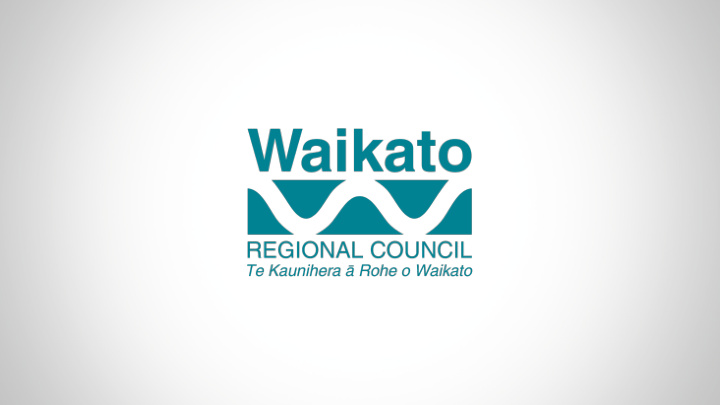



WAIKATO REGIONAL COUNCIL 2019/20 Annual Plan Budget
Annual Plan process • December 2018 – • Council meeting on key matters to be included in the 2019/20 Annual Plan. • Budget approved, subject to confirmation of specific budget matters • March 2019 – • Draft Annual Plan budget approved by council, following update on key matters from December • Today - • Presentation of CE’s submission to Draft Annual Plan budget, to address matters that have arisen since March 2019 • Approval of budget to be included in the 2019/20 Annual Plan • 27 June - • Adoption of Annual Plan and setting of rates
Budget overview • Annual Plan budget has been based on Year Two of the 2018 – 2028 Long Term Plan (LTP) • LTP projected an increase in rates revenue from current ratepayers of 8.8 per cent • The Draft Annual Plan revised this projection down to an increase of 7.8 per cent • 4.5 per cent all property rates; 11.8 per cent targeted rates • The final Annual Plan budget proposed results in an increase in rates revenue of 7.5 per cent • 4.5 per cent all property rates; 11.2 per cent targeted rates
Key budget assumptions • Inflation has been absorbed within many budgets. Provision is made when contractually required • Regional growth is projected at 1.8 per cent – based on actual growth achieved last year • The proposed budget includes provision for market and performance increases in staff remuneration of 2.5 per cent • Salary provisions are discounted to reflect expected turnover (10% turnover, and a 10 week recruitment gap)
Key budget assumptions • Actual rates incurred will be impacted by property revaluations. Five councils have undertaken general revaluations this year • Hauraki District • Matamata-Piako District • Waitomo District • South Waikato District • Hamilton City
LTP commitments impacting 2019/20 • The LTP locked in certain funding commitments that are reflected in the proposed rates increase: • Spreading catchment rate increases over first 3 years of the LTP • Capital contribution to the proposed Waikato Regional Theatre • Commencement of the Hamilton to Auckland passenger rail services
Waikato Regional Theatre rating • The LTP budget assumption includes the release of council’s contribution of $2.5M (of the $5M) to the Theatre project in 2019/20 financial year. This funding is via external borrowing. • To repay the borrowing, a targeted rate assessed over a 20 year period is commencing from 1 July 2019 (rating impact equivalent to half a rating year), with full rating impact being recognised in 2020/21 financial year. • The funding deed for the Theatre will not be signed prior to May 2019 as signalled to council. It is staff recommendation that rating be deferred until 1 July 2020.
Rail Budget Update • Programme Manager has been working with partner organisations to confirm project deliverables, timelines and costings to meet NZTA pre implementation requirements • Decision to confirm implementation funding is still subject to NZTA Board approval • Rail Governance Group has recommended: The provisional start date be retained at April 2020, as per the Council report. KiwiRail will confirm with a greater degree of certainty the rolling stock programme completion date by August 2019. Implementation Marketing budget be increased from $90k to $160k • Our supplier has advised that preferred Ticketing solution CAPEX costs increased from $300k to $563k max.(funded NZTA 75.5% and WRC share from reserves),subject to agreement of functionality and negotiation • Increased ticketing system depreciation costs will be partially offset by reduced OPEX costs
Rail P&L – Council report v/s 27 May Update
General Comments – Rail Budget Changes • The WRC share required for 2019/20 has increased from $663k to $689k to fund the increase in ticketing operational costs, depreciation costs and marketing implementation costs at 24.5%. • In the full year of operations (2020/21), the Ticketing operational expenditure has decreased from the previous $80k budgeted amount to $40k. Thus the increase in ongoing depreciation costs per annum from 80k to $133k will be partly funded with the savings from ticketing. • However, the increase in unfunded depreciation is greater than the savings obtained from ticketing OPEX, therefore the total WRC share required for 2020/21 has increased from $1,659,000 to $1,675,000 (16k increase). • It is important to note that WRC’s operations budget has as contingency margin of 9%, which is made up of unidentified costs, fuel contingency and an overarching contingency margin of 5%.
Updated Reserve Fund Transfer Summary – 2019/20 Reserve transfers Value NZTA Revenue for the Capital costs transferred to reserve ($662,763 x 75.5%) * $500,387 Repayment of the 2018/19 deficit** $45,500 Total $545,887 Less deficit relating to unfunded depreciation on capital items ($33,000 depreciation x 51%) ($16,830) Total $529,057 * The set up costs include $662,763 of capital costs for which WRC will receive $500,387 NZTA funding at 75.5%. This is treated as revenue in the council’s accounts and results in an accounting surplus ** Cost relating to branding/naming, WIFI and ticketing pre-implementation activities brought forward to the current year to meet NZTA approval requirements
Recommend
More recommend